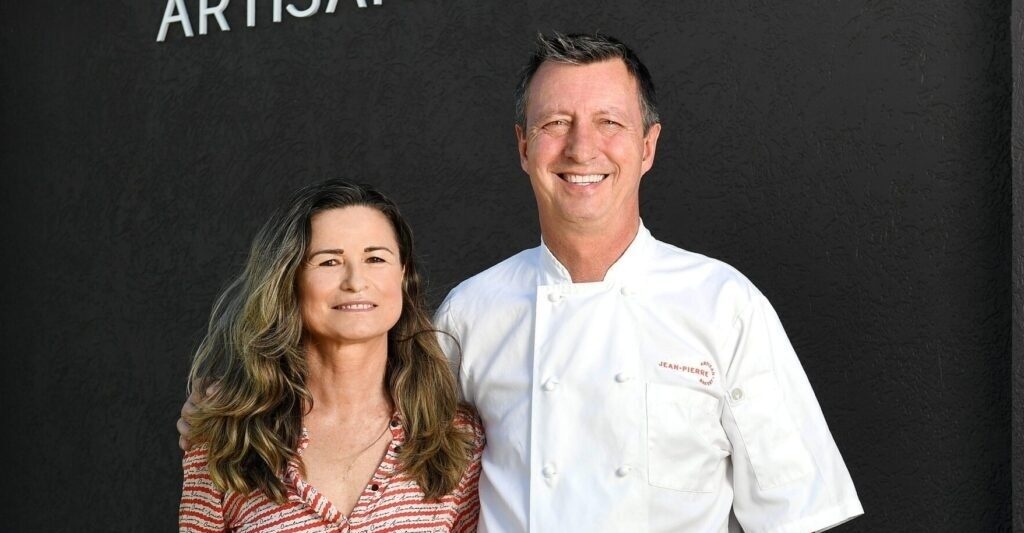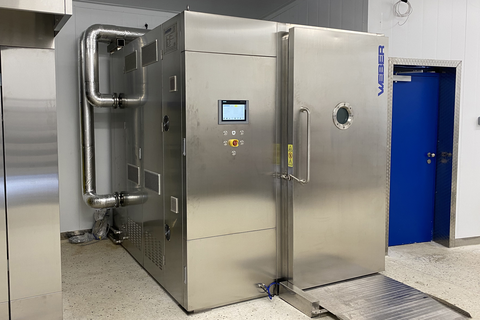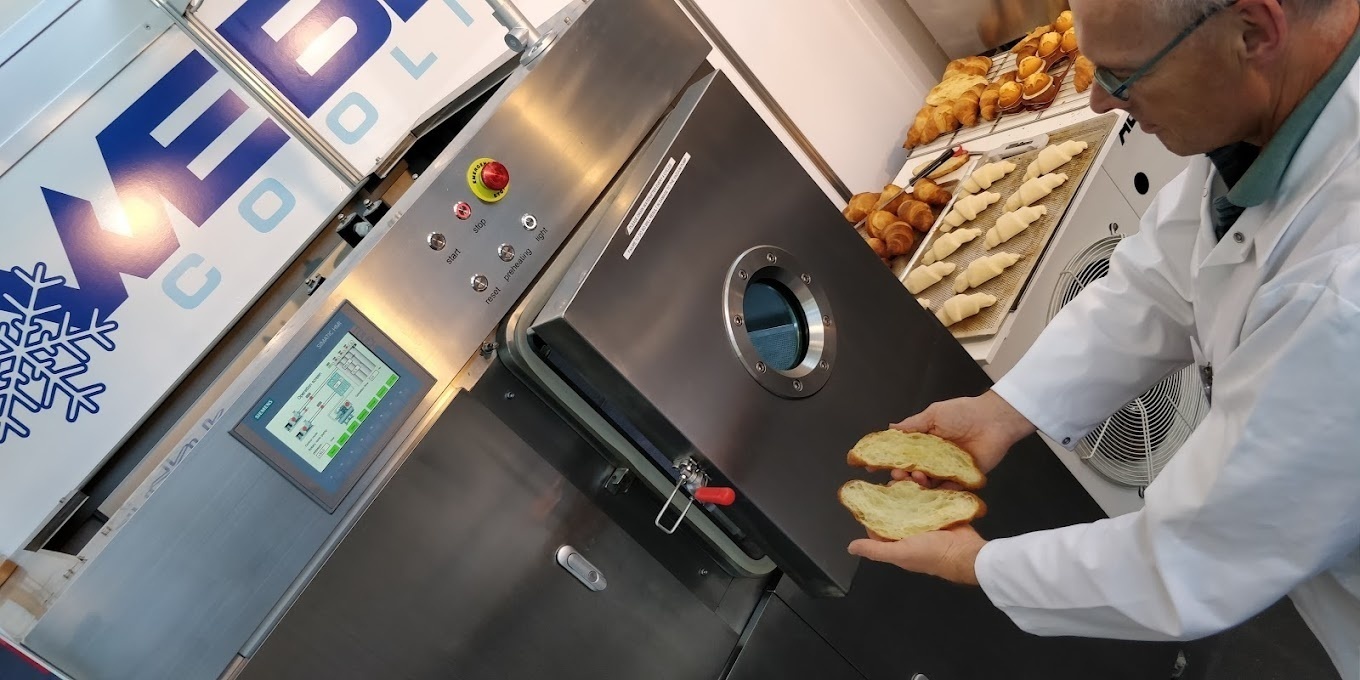Vacuum Cooling Advances Baking
World Bakers: febr 27, 2019
Vacuum cooling has been around for decades, but it’s only today that the technology has reached a level of maturity high enough to gain widespread acceptance especially for bakery applications. Several reasons have prevented this acceptance before.
Vacuum Cooling in Bakery
The first is the fact that – contrary to all other vacuum cooling applications, for bread & bakery, vacuum cooling will directly influence the quality of the product, as the baking process continues in the cooler. One needs to understand the implications, and adapt their process to it, reducing baking times, increasing oven temperature and even sometimes modifying the proofing time and recipe. Failing to consider these modifications will prompt undesirable effects on product quality. Embracing the advantages the technology can bring, however, will result in premium bakery products, with respect to structure, volume, shelf life & optimum crispness.
Another reason has been the availability of (affordable) vacuum coolers suited for bakery applications. Vacuum cooling professionals from Weber Cooling, Koenig-Rex and BVT Bakery Services shared their expertise with European Baker & Biscuit, in order to help us clarify some of the complexities of this technology.
End Product Benefits
Vacuum cooling can be used for almost all bread types. “Some bread types (like gluten free and products with high rye and wheat content or with a high water content) are more difficult to cool, but adapting both the vacuum cooler as well as the baking process, makes it possible to prepare even the most difficult product,” explains Hans Juursema, CEO of Weber Cooling.
He goes on to detail some of the undeniable benefits of using vacuum cooling:
- A larger volume, as during the cooling process there is a pulling effect on the bread, resulting in a volume increase;
- A more homogenous and tender internal structure, as the gelation process continues under vacuum, giving a finer structure, and even a whiter color;
- A crispier crust which will stay crispy for a longer time, as the moisture is mostly sucked out (also for cookies: less moisture will lead to a longer crispness!);
- Longer shelf life, as less bacteria will be formed during the minimalized cooling time.
Patrick Duss, Executive Director Vacuum Cooling at BVT Bakery Services takes the argument even further by bringing up energy saving and food regulations:
“Roughly speaking we can see advantages in substantial savings of space, time and energy and an impressive improvement of the product quality.
The looks, volume, taste and healthiness of the products can substantially be improved due to vacuum cooling. Health authorities demand a serious reduction of sugar in future recipes and a chemical treatment of the bakery products nowadays is unwanted. In this respect vacuum cooling is no less than a game changer. A higher amount of water in the recipe (up to 4-12% ) without influence on the amount of evaporation, automatically reduces the percentage of other ingredients and leads to a better volume and taste,” he points out.
Working with Artisan Bakers
The customers can generally be divided into two groups: artisan versus industrial. Weber Cooling currently serves only the artisan customers, working with normal (rotary) ovens.
“Most economic advantages can be achieved with a capacity of three ovens, as you will be able to reduce your baking time by up to 40% (on average 30%). The installation of a vacuum cooler will bring you substantial more capacity; the more ovens, the more capacity you will gain! In practice, one vacuum cooler will serve up to 5 ovens, resulting in up to 2 “oven capacities” extra, free of charge,” the specialist with Weber Cooling explained.
The industrial customers require a continuous solution. This can be supplied by means of a multi-level vacuum cooling system. The investment level here is substantially higher; and the number of systems supplied here is still limited. For this market group Weber Cooling is currently designing its first solutions and expects to supply a first solution in 2019, Juursema with Weber Cooling said.
Talking about main advantages of using this technology in a bakery, quality increase should be the main driver, the specialist underlines.
“For gluten-free bakeries the introduction of vacuum cooling is a no-brainer; the advantages vacuum can bring are just that huge. With vacuum you can easily bake even the most difficult gluten free recipe and can produce bread which has a texture and bite comparable to normal bread”, said Juursema.
The economic advantages, however, also can play an important part, not only by increasing your capacity by up to 40%, but also because you can save on all your cooling costs and you can reduce your cooling space by 90%. Adding a vacuum cooler can bring you just so much more capacity – while reducing your space & cooling requirements at the same time.
Working with Industrial Bakers
Within the bakery industry, the specialists with BVT Bakery Services see different levels of demand. In a small and mid-size bakery, a system runs between 4 and 8 hours a day, 5-6 days a week. In the bakery industry a system has to be equipped to run 24/7, a year. This means the level of reliability and process knowledge is completely different and can only be offered after a process of development based on experience that has carefully been build up in years, the specialists explain.
Furthermore, the advantages and applications of vacuum technology in the food production is almost unlimited. Vacuum Cooling customers of BVT Vacuum can be found in a wide range of food production segments, from bakery to ready meals, pasta, vegetables, rice, etc. “In the baked goods business we start from approx. 1.000Kg per hour. One of our biggest installations reaches up to 22.000 kg/hour (in this case cake products). All our biggest systems are customized, ” Duss explains. There are no standard sizes, because of the variability of the oven size, product size etc. The majority of their customers produce on an industrial scale.
“A golden rule in the baked goods business is: the shorter the production process, the better the parameters can be controlled,” the expert added. Finally, the working principle of vacuum cooling is based on a physical law: reduction of the pressure reduces the boiling temperature of water. BVT Vacuum explains that the evaporation of water leads to lowering the temperature of the processed product. The energy produced in the baking is recovered with significant higher efficiency, resulting in a better energy balance. A conventional cooling system is based on less efficient cooling energy, in order to cool down the products.
Shortening the Process
Wolfgang Staufer, CEO of Koenig-Rex, explains that, in the past, loaves of bread often needed to be moved across cooling coils and cooled for hours. With vacuum technology, on the other hand, only a few minutes are usually sufficient to bring the products to the right temperature for cutting and/or packing.
Vacuum conditioning cools and stabilizes rolls, pastry or bread in only a few minutes for further use. This process stage streamlines the downstream logistics chain, increases product quality, improves efficiency of the oven and extends product shelf life. In addition to improving product quality and extending the shelf life, vacuum conditioning offers another decisive advantage in terms of baking: the process shortening. “By vacuum conditioning, the water content is minimized in the stabilized part-baked products and this results in reduced baking time. For example, brioche rolls become juicer in taste by stabilization in the vacuum conditioning and minimized baking time. There is no limitation to products: with various adjustable cooling curves and storable programs, vacuum conditioning makes it possible to simplify process steps for different kinds of baked goods,” the expert with Koenig-Rex added.
Part-baked frozen products such as bread, rolls, pastries, pizza products, cakes can already be precooled in the vacuum chamber. Partly baked, ready-made pizzas can be cooled quickly to prevent the soil from getting wet.
Koenig supplies industrial as well as small-sized bakeries worldwide with the adequate baking equipment. Industrial customers are rather interested in continuous vacuum conditioning for their automated bread production and mid-sized bakeries are often interested in batch vacuum conditioning and for delivering stabilized and vacuumed rolls to their bakery stores.
A Market Overview
The demand for vacuum cooling has grown in the recent years, both companies agree.
“The market is growing – as more and more bakeries see how others profit from the technology. The future driver for accelerated growth comes from Weber Cooling; we’ve reduced the average cost price of vacuum coolers by roughly 40 – 50 % and can offer vacuum coolers for the same price a customer now buys an oven; customers understand these price levels, and can easily calculate that their payback time now is reduced to only a few years!”, Juursema with Weber Cooling said.
On the other hand, Duss with BVT Vacuum remarked the growth in the past 3-5 years, based on the ability to produce reliable high-tech equipment. “We have the ability to produce reliable, high-tech equipment. Drivers for the future will be the high demand on convenience of the market and health restrictions of several products, in terms of clean label production, reduction on sugars and chemical treatment of products to improve shelf live. Needless to explain, the reduction of CO2 in the total footprint of the future food production process which has become a priority in all our customers view for the future,” the expert with BVT Vacuum concluded.




